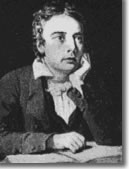Second generation Romantic Poet, John Keats was born in London on 31 October 1795, to a livery stableman and his wife. His early education was at the Reverend John Clarke's school in Enfield and at the age of fifteen he was apprenticed to a surgeon. Following his apprenticeship he underwent further training at Guy's Hospital, London. Keats completed his qualifications in medicine, howeve,r he soon abandoned the profession in favour of that of a poet. This career transition was greatly aided in 1816 when Keats made the acquaintance of radical journalist and poet Leigh Hunt. His relationship with Hunt proved an affectionate and beneficial one that enabled him to associate with other literary figures including Percy Shelley.
In 1818 Keats fell in love with Fanny Brawne and the pair became engaged, however, due to financial difficulties, their relationship failed before the couple were wed. In 1820 Keats developed tuberculosis, a disease that has already claimed the lives of his mother and younger brother. In the hope of benefiting from the milder climate, Keats travelled to Italy in 1820, dying in Rome aged 25, in the spring of 1821.
There are many influences to be found reflected in the poetry of Keats, and this may be a result of the fact that his short life failed to provide him with the time frame for his own style to fully mature. It is widely believed, based on the quality of his poetry produced over a few short years, that had Keats lived a longer life, his skill and achievement as a poet would have eclipsed that of his contemporaries.
 The earliest influence encountered in Keats's work is the Elizabethan verse of Spencer, and the earlier poet's mannerisms feature highly in his first published volume Poems (1817), which includes an early attempt at Spenserian verse, "Imitation of Spenser" written in 1813. Poems was received without much enthusiasm by critics and the reading public and while his second published volume Endymion, (an intricate and eloquent allegory published in 1818) attracted more reviews, they were often scathing and labelled the work as ‘crude and flawed'. However whilst still revealing a level of immaturity, Endymion was quite an accomplishment in itself being a substantial work of over 4000 lines and Keats's first attempt at epic poetry. Keats made further attempts at Epic writing, most notably Hyperion. Recounting the primeval struggle between the gods, the poem is an attempt to re-write a secularised Paradise Lost. Sadly the work remains a fragment, with Keats commencing work in 1818 but abandoning it in 1819 when his health began to fail.
The earliest influence encountered in Keats's work is the Elizabethan verse of Spencer, and the earlier poet's mannerisms feature highly in his first published volume Poems (1817), which includes an early attempt at Spenserian verse, "Imitation of Spenser" written in 1813. Poems was received without much enthusiasm by critics and the reading public and while his second published volume Endymion, (an intricate and eloquent allegory published in 1818) attracted more reviews, they were often scathing and labelled the work as ‘crude and flawed'. However whilst still revealing a level of immaturity, Endymion was quite an accomplishment in itself being a substantial work of over 4000 lines and Keats's first attempt at epic poetry. Keats made further attempts at Epic writing, most notably Hyperion. Recounting the primeval struggle between the gods, the poem is an attempt to re-write a secularised Paradise Lost. Sadly the work remains a fragment, with Keats commencing work in 1818 but abandoning it in 1819 when his health began to fail.
The third and final published volume of Keats's poetry is Lamia, Isabella, The Eve of St Agnes, and Other Poems (1820). The Eve of St Agnes is arguably the finest example of Keats' narrative poetry and is the tale of the elopement of two lovers. Whilst there is some reflection of his earlier fascination with Spenserian stanza, the poem is uniquely Keats's own, as it employs the rich imagery and descriptive beauty which remain his legacy. This obsession with flawless beauty can also be see in many of Keats's famous Odes including To A Nightingale, On A Grecian Urn, To Psyche and To Autumn.
As a Romantic poet, the subjects employed in Keats's poems differ from those of his contemporaries. Like Wordsworth, Keats held a deep love of nature, however where Wordsworth's appreciation of the natural world was firmly anchored in the Divine, Keats's appreciation is almost entirely physical. And while Shelley's poetry is imbibed with a strongly prophetic vein, Keats concerns himself mainly with the stuff of legend and myth. But for Keats, great poetry and indeed great poets, were made by those who possessed the ability to fully absorb and respond to life. He gave this concept the term Negative Capability and defined it as “when a man is capable of being in uncertainties, Mysteries(sic), doubts, without any irritable reaching after fact and reason”. Further Keats saw the imagination as the active quality of the mind stating “What the imagination seized as Beauty must be truth – whether it existed before or not.” (Keats in Rogers, 1987, pg308).
Other works of Keats include the lyrical ballad "La Bell Dame sans Merci", "The Fall of Hyperion, a Dream" (a partial reworking of Hyperion), and an extensive collection of letters that give an insight into his own growth as a person and as a poet. At the time of his death he had published only 54 poems and his reputation was still minimal, however the admiration of other literary figures such as Shelley who composed Adonias in his honour have ensured that history recognises John Keats as one of the greatest English poets.